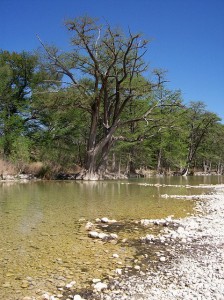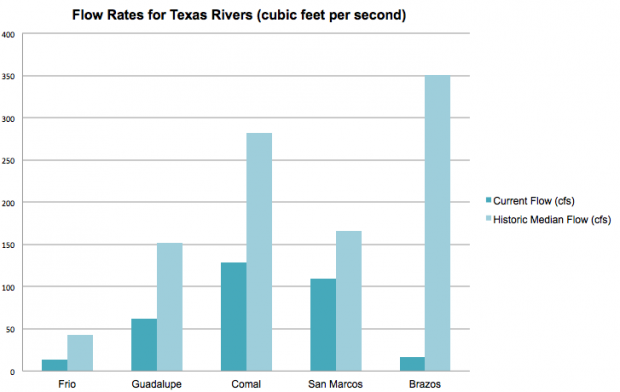Despite the Drought, Texans Are Still Tubing
To his surprise, Jerry Bates has had a busy summer.
Bates owns Frio River Outfitters & Happy Hollow Grocery in Concan, a small Hill Country community 90 minutes west of San Antonio. In addition to selling basic groceries and camping equipment, Happy Hollow’s main business is renting out tubes and kayaks to tourists on the Frio River.
Bates’ livelihood depends on the Frio, and even though the river has been down, business is up.
“It’s been probably one of the busiest summers we’ve ever had,” he said. “Which is amazing, because the river levels are pretty low right now.”
The low levels are a consequence of Texas’ drought, which continues to dry up bodies of water throughout the state. That includes rivers like the Guadalupe, Comal, San Marcos, and Brazos, all of which are popular tubing destinations.
Several rivers are flowing at historically low rates, and are so shallow in some places that would-be tubers have to walk for a significant part of their journey.
Even so, tube rental outfits haven’t reported a decline in their business this summer, despite the challenges presented by the weather.
A Narrow Window
That’s important for a business like a tube rental, which makes 90 percent of its revenue between June and August. Bates says that if the tubers don’t come to the river this time of year, his business is sunk.
“Kind of like a farmer with a bad crop, only they’ve got some kind of crop insurance. We don’t have any tube insurance,” Bates said.
Not that he couldn’t use it. Texas rivers are flowing slower and lower because of the drought, which makes it tougher to tube. Bates says that tubing routes that used to take 90 minutes can now take as long as four hours, much of which is spent walking through spots in the river that are too shallow to float through.
Still, Texans are coming to the river, and tubing companies are making money.
Further south, Whitewater Sports in New Braunfels runs an operation that’s similar to Happy Hollow, except on the Guadalupe. Danette Beasley is the assistant manger for tubing there.
“We haven’t really seen much of a drop in tubers [compared to other years],” she said. “I think [customers] realize that Texas has been in a drought the last three years, but they just come to enjoy the water and the company they come with.”
Statistics for how many tubers visit Texas’ rivers each year do not exist. But for now at least, the drought doesn’t seem to have kept many people away. Neither Beasley nor Bates say that they’ve heard many complaints from customers, who seem to know what they’re in for.
“When they come in and ask about it we tell them exactly what to expect,” Bates said. “It’s going to be low and slow, and wear some good walking shoes because you’re going to be walking in between [swimming] holes. If you’re here thinking it’s Schlitterbahn [Waterpark], you probably just should go to Schlitterbahn.”
That doesn’t mean though that they’re not concerned about what the future may hold.
No one knows when the current drought will end, and although it hasn’t effected their bottom line yet, tubing companies aren’t sure how long that will be the case.
“You get to two or three years of really low river, then it starts to affect you a lot more.” Bates said. “People start looking for something else to go and do.”


